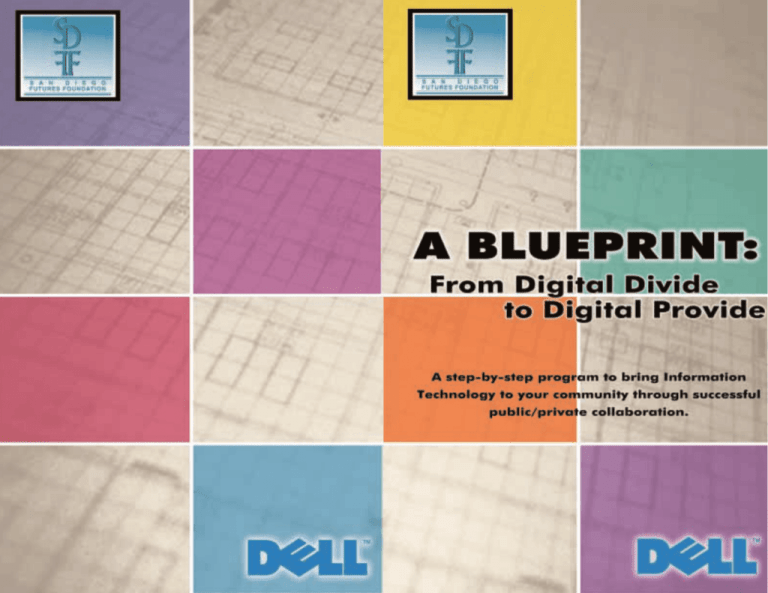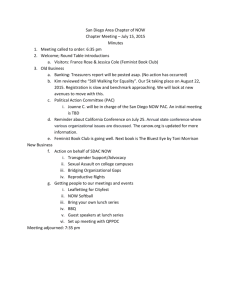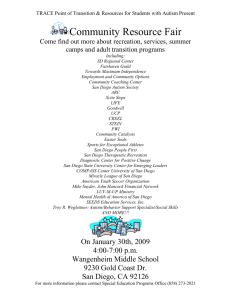
How San Diego County, California,
used an innovative IT outsourcing
initiative as the springboard to a
county-wide outreach program
to bridge the digital divide.
d
nte
Pri
01
20
er
b
m
ve
No
ABOUT THIS GUIDE
Dell™ Computer Corporation and the San Diego Futures Foundation
(commonly referred to as SDFF or the Foundation) are proud to present
this unique history and guide. It provides a "blueprint" on how to
establish a community-based program to address an issue of great and
growing concern: The "digital divide" – the gap between those people
who do and do not have access to a personal computer or the Internet
and who do not have the skills necessary to use technology. The
approach outlined in this plan is based on the premise that a
collaborative effort of public and private partnerships is critical to the
success of a long-term program.
This initiative represents a perfect example of Dell's ability to develop
one-to-one relationships with our customers to help ensure that we
respond to their unique needs. In fact, it reflects one of our major
goals: ensuring that we assist customers in achieving their business
and constituency objectives.
The architect of Dell's portion of the plan is a senior marketing manager
who has spent four years on the board of directors of an Austin-area
non-profit organization. As she traveled the United States on behalf of
Dell, she repeatedly presented the SDFF story to various groups,
including a national forum of public administrators. Their keen interest in
a business-oriented approach to the problem of the digital divide – one
that involved creating "financial self-sufficiency" – was one of the
motivating factors in the preparation of this guide.
2
HOW SAN DIEGO COUNTY WENT FROM
OUTSOURCE TO OUTREACH
In 1999, the Board of Supervisors of San Diego County, California, voted to enter
into what is believed to be the biggest state or local government technology
privatization arrangement ever. The county sought to remove itself from the IT
business entirely by outsourcing all of its computer and telecommunications
operations to private enterprise.
But that's just the beginning of the story.
As part of the proposal process, the County Board of Supervisors required all
competing entities bidding on the outsourcing contract to include in their proposals
an "added value" plan for giving back to the community of San Diego. This plan was
to be above and beyond the requirements in the IT outsourcing contract.
Computer Sciences Corporation (CSC), one of the world's leading consulting and
information technology services firms, teamed with another technology giant,
Science Applications International Corporation (SAIC) of San Diego, California to
form "the Pennant Alliance." Joining them was Pacific Bell and Avaya Inc., worldclass providers of telecommunications and electronics. The Pennant Alliance was
awarded the seven-year $644 million contract. The solution for the added value
requirement was the creation of the San Diego Futures Foundation, a 501(c)3 nonprofit organization, with the purpose of giving back to the citizens of San Diego
County.
Specifically, the Foundation was established to:
• Ensure all residents of San Diego County had access to IT resources
• Increase computer literacy
• Provide computer-related job training to a broader range of county residents
The Foundation provided a solution to a dilemma facing not only San
Diego County, but any government entity endeavoring to
expand e-government capabilities.
3
WHY
IS
DELL INVOLVED WITH AND COMMITTED
DIEGO FUTURES FOUNDATION?
TO THE
SAN
Dell was selected by the Pennant Alliance to provide the necessary hardware and
services required to help fulfill San Diego County's vision of e-government and its
goal of having constituents conduct their business with the county online instead
of in line. As part of that innovative team, Dell was also very interested in the
Pennant Alliance and San Diego County's shared vision of ensuring that
underrepresented citizens had access to those online-government services
through the San Diego Futures Foundation. This shared vision parallels Dell's own
goal of ensuring equal access to technology. It was a natural fit, therefore, for Dell
to work with the San Diego Futures Foundation to develop this blueprint and to
share best practices.
In the case of San Diego, Dell was able to not only provide the needed hardware
and services to the Pennant Alliance, but was also able to bring additional
resources and community outreach experience to assist the County and the
Foundation in their digital inclusion efforts. Dell is pleased to have developed a
collaboration that represents how private/public partnerships can work to meet
the needs of the community. Dell is interested in supporting State and Local
Government customers whose vision in equipping communities for the digital
world match our own. Our focus is on:
•
•
•
•
Inclusive technology access and training
Building simple, sustainable and repeatable programs
Innovative approaches for reaching all underserved communities
Ensuring a long-term commitment of time, resources and enthusiasm
THE VALUE PROPOSITION
For e-government to succeed, it must be
accessible to all citizens, including those who
currently may not have access to computers
and the "information highway."
Since its inception, the Foundation has
developed comprehensive plans to
provide not only computer hardware,
but software, services, training and
technical resources for the
community as well.
4
Its mission statement sounds ambitious, but the San Diego Futures Foundation
has been an astonishing success:
"The San Diego Futures Foundation is committed to helping bridge the Digital
Divide in San Diego County. Our mission is to make information technology
available to the broadest range of San Diego County residents, through the
delivery of computer hardware, software, communications, training and
education. The Foundation works to achieve this goal by facilitating collaborative
partnerships with community-based organizations, non-profit organizations,
volunteer groups, government, businesses, and community leaders throughout
the San Diego region. The Foundation also pursues grants, contributions,
technology industry partnerships, in-kind donations and other resources to help
fund projects related to our mission."
During its first 18 months, the Foundation delivered 2000 computers to more
than 100 schools and local organizations throughout the greater San Diego area.
It established an intern program
to provide technical support and
training and conducted 50
teacher workshops involving
more than 1100 local educators
from a wide variety of servicebased organizations. The
Foundation has also initiated a
community-facing Web site called
CountyNet, and was honored
with two prestigious awards for
its innovative leadership and
community partnership.
During its first 18 months, the Foundation delivered 2,000
computers to more than 100 schools and organizations.
The program works for three reasons:
• It has the full support of both county government and private industry.
• It makes maximum use of existing resources. No reinvention of the
wheel here.
• It takes a results-oriented business approach through a dedicated,
professional staff and Board of Directors who maximize best business
practices.
Although the Foundation's annual operating budget is $100,000, the value to San
Diego citizens in terms of increased access to computers, the Internet,
technology training and e-government services is immeasurable.
5
BLUEPRINT OVERVIEW
This blueprint is divided into four "Steps."
1.
2.
3.
4.
Building the infrastructure
• Refurbishment and service delivery through Technology Outreach
Centers
• Interns
• Volunteers
• Call Center and Help Desk
Setting a menu of programs and services
• Computer donations
• CountyNet
• Small/Disadvantaged business outreach
• Teacher workshops
• Teacher mentors
• Technology training for girls
Strategic partnerships
• The County of San Diego
• The Pennant Alliance
• Dell Computer Corporation
• Microsoft
• Other strategic partners
Bridging the digital divide in your community
• Structure
• Leverage
• Partnership
• Sustainability
As with any program as far-reaching and multi-faceted as the San Diego Futures
Foundation, these steps often can and do overlap. And since each different state,
county and local situation may call for variations on the San Diego solution, these
steps should be seen as workable suggestions that can help provide a framework
for a program customized to meet your specific needs.
6
An initial challenge for the Foundation was to determine
how service would be delivered. With an expected 3,000
to 5,000 computers
coming out of the county
every year, along with the needed technical
support and training to go with them, the
Foundation needed a way to deliver
services to the schools and organizations
that it serves. This is where SDFF got
creative. With a staff of only three full-time
employees, the Foundation leveraged
existing community resources as ways to
refurbish the donated systems and to
Technology Outreach Center students delivering
deliver effective service.
computers for an after school program.
REFURBISHMENT AND SERVICE DELIVERY:
TECHNOLOGY OUTREACH CENTERS
As a way to get computers ready for donation to the community, SDFF enlisted
the help of community colleges, technical vocational schools and other
organizations to establish Technology Outreach Centers (TOCs). TOCs act as
distribution and service hubs to help refurbish computers, build and test
networks, deliver systems and networks to recipients, provide training and other
educational programs and host on-site and other technical services for each
region of the county. SDFF has five TOC partners, including Palomar College,
San Diego City College, National City Adult School, Pangea Foundation and
Epicentre-The San Diego Regional Teen Center.
TOC students are enrolled in computer repair and networking classes and
refurbish computers on behalf of the Foundation. By working on the donated
machines, students get real-world experience, rather than tearing down and
reassembling the same school computers over and over again. The donated
systems are not only refurbished, but, where possible, upgraded by the students.
Students install operating systems and necessary drivers as well as other system
components.
7
The TOCs have the facilities, classes, and students to provide this service to the
Foundation because they are already teaching IT courses. By leveraging these
existing resources, the Foundation incurs no additional costs for facilities and
other resources. The Foundation purchases additional peripheral hardware, such
as CD-ROM drives, modems, network or sound cards. Once the computers have
been refurbished, the Foundation makes arrangements with each receiving
organization for them to be delivered or picked up.
The benefits to the Technology Outreach Centers include educational
enhancement through on-the-job training in computer hardware and network
development, expansion of technology educational offerings to students,
partnering opportunities with the technology community and links to hardware
resources. SDFF works with each TOC to develop programs where the TOC can
use some of the computers it refurbishes in conjunction with its own plans. One
TOC uses SDFF computers to establish labs where they can teach A+ Computer
Training classes to high school students. Another established an adult computer
literacy program for community members, and yet another prepares computers
for the city and county's after-school programs.
INTERNS
The Foundation uses college-level computer engineering student interns to install
and support the computers and networks it provides to its clients. Through
specific partnerships, students gain real-world work experience while helping
provide the Foundation's clients with a high level of services. Interns gain
experience in working and consulting with clients, creating networks,
troubleshooting issues and managing real-world projects. In addition to gaining
valuable workforce skills, interns help the community by providing technical
support to organizations that offer social services to seniors, veterans, the
disabled, low-income and under-served communities. Interns also provide training,
graphics, Web design, and Web development services and can earn college credit
through their internships.
Interns are recruited through the TOCs, vocational training schools and the
Foundation's Web site. Any intern who would like to gain three units of college
credit for service to the Foundation can do so by enrolling at a specified
community college. The Foundation will pay the
tuition cost for this credit. As requests for services
are received, the Foundation's Technology Director
assigns specific tasks to interns based on an
assessment of their education, training and
specific skill sets and then closely supervises
and monitors their work. As interns gain more
experience, some are assigned as project
managers for specific tasks or sites.
8
VOLUNTEERS
SDFF uses a large number of volunteers throughout the community to provide
technology training and assistance, to assist in transporting computers and
equipment, to install computers and to assist with various Foundation programs.
Volunteers from organizations like Women
In Technology International and
Techniquelle contribute to SDFF's
success.
Although the Foundation has a volunteer
form on its Web site, most of the
volunteers have been recruited through
word of mouth. For instance, when the
Foundation wanted to provide a
Technology Training for Girls program, a
number of women working in the
San Diego County Supervisor Pam Slater, pictured
left, takes an interest in Technology Training for Girls
technology industry volunteered to
program.
assist. Those women were able to draw
upon their work and social communities for additional volunteers and financial
support. Other community organizations also provide volunteers to assist.
However, the most important and successful method of recruiting volunteers has
been simply to tell the community about the Foundation's goals. It seems that
everyone wants to help this winning cause.
CALL CENTER
AND
HELP DESK
Working with Foundation College San Diego, a nationally accredited technical
college that offers a variety of computer courses, including PC Support/Help
Desk classes, SDFF established a Call Center and Help Desk to provide better
quality service to its clients. Students who attend Help Desk training at the
college become Help Desk Analysts for two hours each day. The Call Center gives
SDFF clients assistance with technical issues, but just as importantly, it gives
SDFF staff a way to collect valuable information and learn how they can do a
better job of distributing hardware, tracking issues and providing services.
Local industry partners have donated Help Desk software and are donating their
time and expertise in planning for the initial launch of the Help Desk. Since so
many non-profit and community-based organizations do not have full-time IT
support, Help Desk support can be of great value. Students at the Help Desk get
the opportunity to gain work experience and will also be able to use SDFF's Client
Relationship Management (CRM) software. Since CRM applications are used by
organizations to gather product and service information, obtain quotes, place and
track orders and work toward other e-business service solutions, this experience is
readily transferable to practically any employment opportunity the students may
seek.
9
Programs:
The Foundation has
turned out to be far more
than just a program to collect
and deliver computers. While its core purpose is
to help bridge the digital divide by collecting,
refurbishing and distributing donated computers
to schools, non-profits and community-based
organizations throughout the county, that is just
the beginning of the services it offers. From the
very outset, the SDFF's guiding members knew
that to truly address technology challenges in San
Diego, they would have to provide full end-to-end
services to their clients in exactly the same
manner any successful IT company would.
Consequently, they set about developing an
infrastructure and a menu of programs and
services to offer to San Diego organizations.
The Foundation has turned out to be far
more than just a program to collect and
deliver computers.
COMPUTER DONATIONS
SDFF receives between 3,000 and 5,000 surplus computers per year - systems
discarded and donated as the result of county upgrades. The Foundation only
works with machines that are Intel® Pentium® I, or better. Older systems are sold
for salvage, with the proceeds coming back to the Foundation. The good news for
the community is that after another year-and-a-half, all of the computers coming
out of the county will be three year-old Dell computers with CD-ROM drives. This
means that a larger number of more advanced systems will be available to
schools and non-profits.
To date, the Foundation has received all of its computers through the outsourcing
contract. However, the Foundation has recently begun working with local
corporations to secure other computer donations that can either be recycled or
sold for salvage to obtain funds for upgrading existing systems. Since personnel
resources are limited, the Foundation does not take computers from individual
donors.
10
Applicants eligible to receive computer donations include schools, non-profits and
community-based organizations. The criteria used for selecting an organization for
computer equipment and services includes its ability to provide:
• Public access to the computers
• Computer training to others
• Services to under-represented communities
In addition, the Foundation creates partnerships with other organizations that add
value to SDFF offerings through in-kind donations of peripherals, software, human
capital and other services.
While applications for computer hardware are
reviewed just twice a year, organizations can
receive other services - engineering and
network support, troubleshooting, Web
development, and training classes - at any
time. As part of the application process,
organizations are required to fill out the
Foundation's application that doubles as a
technology planning and assessment tool
(www.sdfutures.org/forms/AssessmentTool.pdf).
This not only assists organizations in planning
Computer delivered to recipient at Chula Vista
for their technology requirements, but helps
Veteran's Home.
the Foundation plan for the appropriate
hardware, software, technical support and training.
COUNTYNET
CountyNet is a technical services program that includes the development of:
• A Web portal to direct the community to public resources
• Low-cost technical services for non-profits
• A Virtual Private Network connecting SDFF with its service partners
Dell will play a vital role in the development and support of the Foundation's
CountyNet initiative. The CountyNet platform will be based entirely on the
powerful combination of Dell computers and Microsoft software. Additionally, Dell
systems engineers and architects will assist the Foundation in the design,
implementation, and support of the CountyNet platform.
The CountyNet.net Web portal is currently being developed by the Foundation's
Technology Director with help from Dell, Microsoft, Internet Strategy, Inc. and a
team of students from the Senior Experience Program in the College of Business
Administration at California State University San Marcos.
11
The portal will provide the public with a one-stop source for locating valuable
community services. Through the assistance of the County of San Diego's Health
and Human Services Agency, CountyNet.net will provide such community
information as crisis lines and emergency contacts, emergency assistance
information, education, employment, family support and healthcare services,
financial and legal assistance, housing information and assistance, youth support
programs, domestic violence programs, substance abuse resources, as well as
services to seniors, the disabled and veterans. In addition, it will provide bulletin
boards, calendars of events, messaging services and links to computer hardware,
software and training.
The CountyNet services plan includes the development of low-cost technical
services for community organizations, including systems engineering,
maintenance, troubleshooting and repair, training, technical consulting, network
setup and maintenance, Web development/hosting/consulting, software hosting
and consulting, Internet content filtering and help desk support. These services
are provided by interns and volunteers and are managed by paid staff.
The CountyNet Virtual Private Network will connect SDFF to its TOCs, Help Desk
and other partners. It will allow SDFF to collect and manage client data, catalog
and manage computer inventory at TOCs, dispatch interns and volunteers for
technical support and provide an overall platform for Client Relationship
Management.
SMALL/DISADVANTAGED BUSINESS-OUTREACH
According to Dr. Waldo Lopez-Aqueres, Director of Economic Policy Research at
the Tomas Rivera Policy Institute, the reason many minority-owned businesses do
not engage in e-business or e-commerce is because of a lack of information and
lack of financial and subject matter resources. Industry leaders report the need for
minority business owners to understand they must become Web savvy to both
grow and maintain their existing business base. Ninety-six percent of all
businesses in San Diego are small businesses and many are minority-owned.
Since current research indicates that many small and minority-owned businesses
do not have a Web presence or the in-house knowledge to conduct e-business,
the Foundation wanted to address this growing technology divide through a Small
Business Outreach Program.
12
This pilot program was started in 2001 with industry experts, including the U.S.
Small Business Administration's Service Corps of Retired Executives (SCORE),
SAIC's Supplier Diversity Office and e-business experts like Internet Strategy,
Inc. and other local Internet companies. The program provides workshops on
the advantages of conducting e-business, including Web pages, e-commerce
and shopping carts. It also includes a partnership with local community college
students who, to gain experience and provide community service, will build
Web sites for small businesses. Businesses were recruited through SAIC's
Supplier Diversity Office, SCORE and local Hispanic print media. The San Diego
Futures Foundation also invited students from its TOCs and other colleges and
universities. SDFF is continuing to evaluate and assess effective ways to
provide technology training to small businesses.
TEACHER WORKSHOPS
Pennant Alliance partner, Pacific Bell, has taken the lead in working with the
Foundation to provide customized workshops and presentations for educators,
administrators and librarians in San Diego County. Workshop and presentation
topics include: searching the Internet, Web content development, information
literacy, Internet safety, videoconferencing and media streaming. Further
support is also provided online by the Pacific Bell Education First Knowledge
Explorer Web site, www.kn.pacbell.com.
The workshops and presentations are provided throughout California by
technology-savvy Education Advocates, all of whom are former classroom
teachers and librarians employed by Pacific Bell. The Advocates share their
experiences and techniques with teachers and librarians by providing
customized training, hands-on workshops and timely presentations by request
at school and/or library site locations. Required workshop participation is a
minimum of ten attendees. Advocates are available at no cost to provide inservice training, staff development, conference presentations and technology
planning assistance. They work closely with Pacific Bell account teams so they
can put education customers in touch with someone who can help them make
informed decisions about telecommunications and technology.
13
TEACHER/MENTORS
Thanks to a grant from Avaya Inc., another Pennant Alliance partner, the
Foundation recently began implementation of a pilot teacher-training program to
provide on-site training and mentoring to teachers at 10 elementary schools in
San Diego. Through this unique program, 10 technology-savvy teachers will be
selected and paid to assist other teachers at their respective schools.
Teacher/mentors will provide general technical help to their peers on-site and will
assist in developing technology use and development plans for each school.
TECHNOLOGY TRAINING
FOR
GIRLS
With the help of participating partners, the Foundation has begun a unique
technology-training program designed specifically for girls. This program provides
age-appropriate technology projects on a weekly basis to selected girls'
organizations and provides the computer hardware, as well. The pilot program
provided Web development training
to teens who assisted in the design
and development of a Web site for a
local girls club. Women volunteers
installed a computer lab at a
selected organization and then
designed and delivered eight weeks
of technology projects for girls ages
five to 13, providing both technical
expertise and successful role
models for young girls. The
Foundation is currently working with
other organizations in San Diego to
provide a one-day symposium for
With the help of participating partners, the Futures Foundation
middle- and high-school girls to
has begun a unique technology-training program designed
specifically for girls.
increase women's participation in
math, science and technology.
14
If Step One is building the infrastructure and Step Two is
setting a menu of programs and services, then the
element that connects and makes them both work is the
establishment of key strategic partnerships.
SDFF's success is due in large part to its strategic partners. Many non-profits,
corporations and civic organizations – like the San Diego Urban League
(www.sdul.org), the Chicano Federation (www.chicanofederation.org) and the
Metropolitan Area Advisory Committee Project (www.maacproject.org) – have all
supported SDFF programs and initiatives by providing a number of resources,
assisting with transportation, refurbishment, training and volunteers. Additionally,
the following partners have played a major role in ensuring its success.
THE COUNTY
OF
SAN DIEGO
In addition to the support and visionary leadership offered by the County Board of
Supervisors, SDFF works with many agencies within the county to obtain data for
CountyNet.net and to obtain
information on programs or groups
that may benefit from its services.
The Foundation recently received
an award from the County's Aging
and Independence Services for
"Innovative Leadership in the
Community" for intergenerational
programs linking students with
seniors, installing computer labs at
senior sites and providing interns
to design and develop a Web site
for organizations providing
San Diego County Supervisor Ron Roberts, pictured standing
left, works with local veteran organization in his districts.
services to seniors. (www.co.sandiego.ca.us)
15
THE PENNANT ALLIANCE
Computer Sciences Corporation (www.csc.com) and Science Applications
International Corporation (www.saic.com) each contributes $50,000 in operating
funds annually to the San Diego Futures Foundation. They also provide three fulltime staff members as an in-kind donation. These companies also provide
facilities, computers and other services to assist the Foundation in its efforts. In
fact, many of the training sessions conducted by the Foundation are held at
Pennant Alliance training facilities throughout San Diego County. The Pennant
Alliance also provides facilities for meetings and other community events. Pacific
Bell (www.pacbell.com) has been instrumental in donating and conducting
teacher workshops for the Foundation and Avaya Inc. (www.avaya.com) awarded
the Foundation $10,000 for its teacher/mentor program.
(www.pennantalliance.com)
DELL COMPUTER CORPORATION
The Dell State & Local Government organization has contributed a limited number
of its peripherals and award-winning desktops to assist the Foundation in
advancing its mission. Dell is working with the foundation to share what it has
learned about digital inclusion from its State & Local Government clients
nationally and the programs being implemented in their communities. Dell also
supports the Foundation's CountyNet initiative by providing the expertise of its
systems engineers who assist other State and Local Government clients in
defining their technical requirements to help ensure proper planning and longterm project success. Because Dell is committed to client success and practices
superior corporate citizenship, as defined in its mission statement, the company
will continue to play an active role with the Foundation in defining and sharing
best practices with other communities who are interested in advancing their
digital divide efforts. (www.dell.com/slg)
MICROSOFT CORPORATION
Microsoft's State and Local Government representatives were early supporters of
the Foundation. Microsoft realized that the Foundation's vision of empowering
people through technology closely resembles their own vision of empowering
people through great software – any time, any place and on any device. And,
because Microsoft is committed to long-term success, they know the value of
contributing to the community and the value of creating a diverse workforce.
Through their partnership with the Foundation, Microsoft will help to ensure that
underserved populations have the opportunity to learn the computer skills needed
in today's work place. Microsoft's contribution of software and technology will
enable the Foundation to develop a solid platform from which to deliver services
and operate its business. This platform will be based on Microsoft's .NET initiative
and will include technologies such as Windows 2000 server, SQL 2000, Exchange
2000, SharePoint portal technologies, MSN Messenger, and Passport
authentication. (www.microsoft.com)
16
COX COMMUNICATIONS
Cox Communications is partnering with SDFF through its Cox Tech Centers
program to mutually identify needed computer centers. SDFF will donate the
computers and installation services and Cox will provide free Internet access to
the specified organizations. To date, Cox and SDFF have partnered at a local girls
club and at a senior center and have selected several other organizations to
benefit from this unique partnership.(www.cox.com)
ARMED FORCES COMMUNICATIONS ELECTRONICS
ASSOCIATION (AFCEA)
SDFF partnered with AFCEA's San Diego Chapter to provide computers to the
AFCEA San Diego Education Committee's "Targeting Needy Schools" program.
SDFF and AFCEA have installed and wired more than 110 computers at area
schools. SDFF and AFCEA recently received an award from San Diego City
schools for this innovative community partnership. (www.afcea-sd.org)
DOITSMARTER
SDFF is working with DoITSmarter to initiate the first Help Desk program for nonprofits. DoITSmarter is supplying Help Desk software, training, technical support
and assistance in establishing this vital program. (www.doitsmarter.com)
INTERNET STRATEGY, INC.
As a leading eBusiness solution provider, iStrategy is dedicated to helping SDFF
bridge the gap between technology and non-profit organizations. iStrategy is
proud to be the development partner in SDFF's CountyNet.net Web portal project.
The company's CEO, Steve Hundley also provides expertise, time, and resources
in developing and presenting workshops for small disadvantaged businesses.
Headquartered in San Diego and founded in 1994, iStrategy's success has been
its strength in recognizing opportunities and defining effective strategies for its
clients, while combining its technical expertise with rapid development and
deployment. (www.istrategy.com)
ST. BERNARD SOFTWARE
This company is providing its iPrism Internet filtering appliance technology for
those SDFF/Cox Communications joint computer technology centers that require
Internet filtering. (www.stbernard.com)
17
Although having a single source of computers to
distribute to the community was a major impetus for the
San Diego Futures Foundation's programs, it is not essential
to establish a non-profit organization to provide similar services.
What is essential to the success of any digital inclusion program, however, is to
have local political support, as well as the right partnerships and a plan that goes
beyond a year or two.
STRUCTURE: The Foundation's Board of Directors consists of representatives from
each of the Pennant Alliance companies (two from CSC), the county's chief
technology officer, and one appointment for each of the county's Board of
Supervisors to ensure equal coverage throughout the county. This board
composition ensures participation by government and industry alike.
LEVERAGE: Cities and counties wishing to implement similar programs need to
inventory existing government, industry, and academic institutions to determine
how these organizations can leverage their resources toward a common goal. In
the case of the Foundation, the use of community resources made it possible to
distribute 2,000 computers with only three full-time staff. Although there is no
direct cost to the County of San Diego, the Pennant Alliance donates three fulltime staff, as well as facilities and support to SDFF and contributes $100,000
annually for operating and program expense, as part of the required contract
commitment.
PARTNERSHIP: The Foundation has been able to partner with others in the
community who provide cash or in-kind services. Having the right level of political
and corporate support can greatly facilitate these partnerships. While the annual
value of SDFF services is substantial, the value to citizens of having increased
access to computers, the Internet, technology training and e-government services
is practically incalculable.
SUSTAINABILITY: The Pennant Alliance proposal for added value to the community
included having the Foundation incorporate as a 501(c)3 non-profit organization so
that it could do fund raising, apply for grants and receive corporate contributions.
The Alliance wanted to ensure that the Foundation remained a viable non-profit
organization long after the San Diego County Outsourcing and
Telecommunications contract is completed.
18
THE FOUNDATION STAFF
BECKY STAWISKI, Executive Director, San Diego Futures Foundation.
Becky has performed in this capacity since December of 1999 when the
organization was first founded. Ms. Stawiski served as the Proposal Manager for
Science Applications International Corporation (SAIC) during the request for
proposal phase of the competitive bid for the San Diego County Outsourcing and
Telecommunications contract. She helped conceptualize the idea of a non-profit
foundation as a way for corporations to give back to the community as part of the
added value to the contract.
As a former consultant to SAIC, she has managed and written proposals for more
than five years. Becky also held full-time positions at SAIC in contract
management, financial control and configuration management. She serves on the
Armed Forces Communications Electronics Association (AFCEA) Educational
Committee, the San Pasqual IT Subcommittee, the Executive Council of the
Academy of Information Technology, the Ray and Joan Kroc Community Center
Education Committee, the Neighborhood House Community Partnership
Committee, and is a LEAD San Diego graduate.
LYNN ANDERSON serves as Program Manager for San Diego Futures Foundation.
Since joining the organization in May of 2000, she has established policies and
procedures, community partnerships, and the Technology Outreach Center
infrastructure for the Foundation's hardware and donation program. As a 14-year
employee of Pennant Alliance partner, Science Applications International (SAIC),
Anderson has held positions in business development, program management,
and applied scientific research and development.
Holding a Bachelor's degree from the University of Minnesota, she is a graduate
of the Chicano Federation Leadership Training Institute and the University of
Phoenix Global Business School. Her community service and professional
organization memberships include Women in Technology International (WITI),
Techniquelle, Toastmasters International, and the Armed Forces Communications
Electronics Association (AFCEA) Scholarship Selection Committee.
JEFF HANCOCK is the Foundation's Technology Director. Jeff has over 16 years'
experience in multi-platform computer systems engineering, programming,
solution development and management with an emphasis on training and
services. He has provided corporate consulting and technical support and sales
and technical training management. He successfully developed and managed
client training for 400 users at the San Diego Workforce partnership and 600
users for the Port of San Diego. Jeff serves as an advisor to many of the local
training schools and Regional Occupation Programs (ROP) and serves as an
advisor to organizations assisting constituents with disabilities.
19
THE ARCHITECT
OF THE
DELL PROGRAM
DEEANNE SAFFORD, Senior Marketing Manager, Government Programs, Dell
Computer Corporation.
DeeAnne is responsible for driving the marketing and advertising that influence
Dell's state, local and federal government sales. She is also responsible for
strategic initiatives and program management for the government sector,
including E-government, digital divide and accessibility.
In addition to her 20 years of experience in the personal computer industry,
DeeAnne is also actively involved in community service. For the last four years
she played an instrumental role as a member of the board of directors for Court
Appointed Special Advocates (CASA) of Travis County, whose mission is to help
find safe, permanent homes for neglected children. One of her key messages is
to work out business partnerships with corporations rather than simply asking for
donations.
DeeAnne earned her Master of Business Administration degree from Nova
University in Fort Lauderdale, Florida.
IS
THERE AN IDEA HERE FOR YOU?
For more information on how a Foundation or similar organization might work in
your constituency, you may contact your Dell account representative or:
Becky Stawiski, Executive Director, San Diego Futures Foundation
858.784.5304
stawiskir@saic.com
or
DeeAnne Safford, Senior Marketing Manager,
Government Programs, Dell Computer Corporation
512.728.9887
deeanne_safford@dell.com
For a look at current SDFF news, please visit their
Web site at http://www.sdfutures.org.
For information regarding Dell's State & Local Government
business, Dell's award-winning product and service offerings, as well as
a version of this blueprint available for download, please visit our Web site at
http://www.dell.com/slg.
© 2001 Dell Computer Corporation. All rights reserved. Reproduction or translation of any part of this work beyond
that permitted by U.S. Copyright laws without the expressed written permission of Dell Computer Corporation is
strictly forbidden. Dell cannot be responsible for errors in typography or photography.
Dell is a trademark of Dell Computer Corporation. Microsoft is a registered trademark of Microsoft Corporation. Intel
and Pentium are registered trademarks of Intel Corporation. Other trademarks and trade names may be used in this
document to refer to the entities claiming the marks and names of their products. Dell disclaims proprietary interest
in the marks and names of others.









